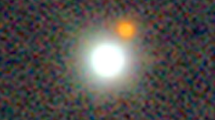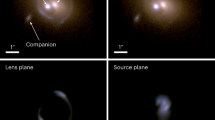Abstract
The recent discovery1 that the two quasars, Hazard 1146+111B,C, separated by 157 arc s, are in fact two images of the same quasar raises the question: what massive object is responsible for gravitational lensing? Ultimately, the answer will be provided by observations of a few more pairs of images of other sources when it will be possible to analyse the mass distribution of the lens. One of the imaginable candidates is a supermassive black hole. No observational or theoretical argument can be presented in favour of this possibility at present. Should the future observations point to a compact supermassive lensing object, the presence of a black hole could be established by the unique property that it would appear against the microwave background as a black spot with a diameter of ⩾0.1 arc s.
Similar content being viewed by others
References
Turner, E. L. et al. Nature 321, 142–144 (1986).
Weinberg, S. Gravitation and Cosmology (Wiley, New York, 1972).
Bardeen, J. M. Black Holes (eds De Witt, C. & De Witt, B. S.) 215–240 (Gordon & Breach, Edinburgh, 1972).
Author information
Authors and Affiliations
Rights and permissions
About this article
Cite this article
PaczyŃski, B. Is there a black hole in the sky?. Nature 321, 419–420 (1986). https://doi.org/10.1038/321419a0
Received:
Accepted:
Issue Date:
DOI: https://doi.org/10.1038/321419a0
- Springer Nature Limited
This article is cited by
-
Some aspects of motion in the Kerr field
Czechoslovak Journal of Physics (1995)
-
Self-similar imperfect fluid cosmologies and the formation of primordial black holes
Astrophysics and Space Science (1992)
-
A small mass, large image separation gravitational lens model
Astrophysics and Space Science (1988)
-
Marginal gravitational lenses of large separation: probing superclusters
Nature (1987)
-
Effect of gravitational lenses on the microwave background, and 1146 + 111B,C
Nature (1986)





